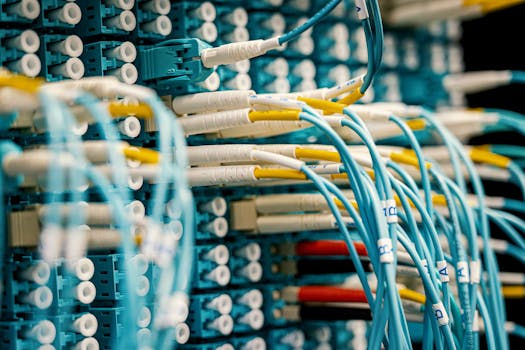
Light at the Speed of Innovation: Exploring High-Speed Data Transmission with Flexible Fibers
Light at the Speed of Innovation: Exploring High-Speed Data Transmission with Flexible Fibers is a cutting-edge technology that has been gaining momentum in recent years. The demand for high-speed data transmission has been increasing exponentially, driven by the growing need for faster and more reliable communication systems. One of the key technologies that have emerged to address this need is the use of flexible fibers for high-speed data transmission.
The use of flexible fibers for data transmission offers several advantages over traditional copper-based systems. Flexible fibers are made of thin glass or plastic threads that are designed to transmit data as light signals. This allows for much faster data transfer rates, with speeds of up to 100 Gbps (gigabits per second) or more. Additionally, flexible fibers are more resistant to interference and signal degradation, making them ideal for use in a wide range of applications, from telecommunications to medical imaging.
How Flexible Fibers Work

Flexible fibers work by using light to transmit data signals. The process begins with the conversion of electrical signals into light signals, which are then transmitted through the fiber. The light signals are generated by a laser or light-emitting diode (LED) and are transmitted through the fiber using a technique called wavelength division multiplexing (WDM). This allows multiple signals to be transmitted simultaneously over a single fiber, increasing the overall bandwidth and speed of the system.
One of the key benefits of flexible fibers is their ability to be easily installed and deployed. They are lightweight, flexible, and can be bent or twisted without affecting their performance. This makes them ideal for use in a wide range of applications, from telecommunications to medical imaging. Additionally, flexible fibers are more resistant to interference and signal degradation, making them a reliable choice for high-speed data transmission.
Applications of Flexible Fibers

The use of flexible fibers for high-speed data transmission has a wide range of applications. In the field of telecommunications, flexible fibers are used to connect homes and businesses to the internet, providing fast and reliable access to online services. They are also used in data centers to connect servers and storage systems, enabling fast and efficient data transfer.
In the medical field, flexible fibers are used in imaging technologies such as endoscopy and microscopy. They are also used in surgical procedures, such as laser surgery, where high-speed data transmission is critical. Additionally, flexible fibers are used in industrial applications, such as manufacturing and quality control, where high-speed data transmission is required for real-time monitoring and control.
Future Developments and Challenges

Despite the many advantages of flexible fibers, there are still several challenges that need to be addressed. One of the main challenges is the high cost of flexible fiber technology, which can make it prohibitively expensive for some applications. Additionally, the installation and deployment of flexible fibers can be complex and require specialized expertise.
However, researchers and developers are working to address these challenges and improve the performance and affordability of flexible fiber technology. New materials and manufacturing techniques are being developed to reduce the cost and improve the performance of flexible fibers. Additionally, new applications and use cases are being explored, such as the use of flexible fibers in IoT (Internet of Things) devices and 5G networks.
In conclusion, Light at the Speed of Innovation: Exploring High-Speed Data Transmission with Flexible Fibers is a revolutionary technology that has the potential to transform the way we communicate and access information. With its high-speed data transmission capabilities, flexible fibers are ideal for a wide range of applications, from telecommunications to medical imaging. As researchers and developers continue to improve and expand this technology, we can expect to see even more innovative applications and use cases emerge in the future.



